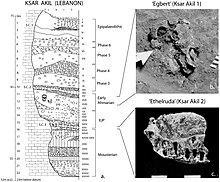Ksar Akil

Ksar Akil ( arab. Inscription Ksar 'Akil ) is an archaeological find place in Lebanon , about ten kilometers northeast of the center of Beirut in Wadi Antelias . Systematic archaeological excavations have been carried out in the abri, with predominantly Paleolithic settlement layers, since the 1920s.
After the discovery by Gottfried Zumoffen in 1900 and a description by AE Day in 1926, the first systematic excavations took place in the years 1937–1938 and 1947–1948. From 1969 to 1975 the Frenchman Jacques Tixier continued the excavations until the Lebanese civil war ended them. The layers found in the cave are around 20 meters thick and rich in fossils and artifacts ; the deepest layers of the find are older than 40,000 years before today ( cal BP ).
Finds
Numerous stone tools were discovered in the cave , as well as the pierced shells of sea snails, which are interpreted as the remains of body jewelry ("pearl necklaces"). Due to the extensive sequence of layers and the finds localized in the layers, the cave is the most important reference point for all Upper Paleolithic excavation sites in the Levant .
In contrast to comparable finds from the Üçağızlı cave about 250 kilometers away , the Ksar Akil artifacts could be assigned “unequivocally” to anatomically modern humans ( Homo sapiens ) based on a hominine fossil . This fossil - the skeleton of a seven to nine year old child, called "Egbert" - was recovered in 1938; its age was determined in 2013 to be 40,850 to 39,200 years ago (cal BP). Of this find (archive number Ksar Akil 1), however, only drawings, images and casts are known today, as the original material can no longer be found as a result of war events in Lebanon. An upper jaw fragment (archive number Ksar Akil 2) recovered from somewhat deeper layers was named "Ethelruda"; it was also considered lost for years, but was rediscovered during an inventory in the depot of the Lebanese National Museum. It has been dated to 42,400 to 41,700 years ago (cal BP).
In 2015 a new date for both fossils was published. According to her, the age of “Egbert” is 43,200 to 42,900 years (cal BP) and the age of “Ethelruda” is approximately 45,900 years (cal BP). This dating of the finds was interpreted as evidence that the colonization of Eurasia by Homo sapiens took place via the Levant .
literature
- Dirk Leder: Core reduction strategies at the Initial Upper Palaeolithic sites of Ksar Akil and Abou Halka in Lebanon. In: Lithics - The Journal of the Lithic Studies Society. Volume 37, 2017, pp. 33-54. ( online , PDF)
- Steven L. Kuhn et al .: Ornaments of the earliest Upper Paleolithic: New insights from the Levant. In: PNAS . Volume 98, No. 13, 2001, pp. 7641-7646, doi: 10.1073 / pnas.121590798
- Christopher A. Bergman and Chris Stringer : Fifty years after: Egbert, an early Upper Palaeolithic juvenile from Ksar Akil, Lebanon. In: Paléorient. Vol. 15, No. 2, 1989, pp. 99-111, doi: 10.3406 / paleo.1989.4512
- Dirk Leder: Technological and Typological Change at the Middle to Upper Palaeolithic Boundary in Lebanon . University research on prehistoric archeology, Volume 255. Verlag Dr. Rudolf Habelt, Bonn 2014, ISBN 978-3-7749-3919-6 (also dissertation, University of Cologne, 2013, abstract , table of contents )
Web links
- Bibliography on the server of the University of Cologne
- Dating of beads sets new timeline for early humans. ( Memento of May 3, 2014 on the Internet Archive ) Oxford University, September 12, 2013
Individual evidence
- ↑ a b Chris Stringer : The Origin of Our Species. Penguin / Allen Lane, 2011, pp. 94-98, ISBN 978-1846141409
- ↑ a b c Katerina Douka et al .: Chronology of Ksar Akil (Lebanon) and Implications for the Colonization of Europe by Anatomically Modern Humans. In: PLoS ONE. Volume 8, No. 9, 2013: e72931, doi: 10.1371 / journal.pone.0072931
- ↑ Marjolein D. Boscha et al .: Levantine route of modern human dispersal into Europe. In: PNAS . Volume 112, No. 25, 2015, pp. 7683–7688, doi: 10.1073 / pnas.1501529112 , full text (PDF)
- ↑ Modern man immigrated to Europe via the Middle East. Press release of the Max Planck Society from June 1, 2015
Coordinates: 33 ° 55 ′ 0 ″ N , 35 ° 36 ′ 0 ″ E

